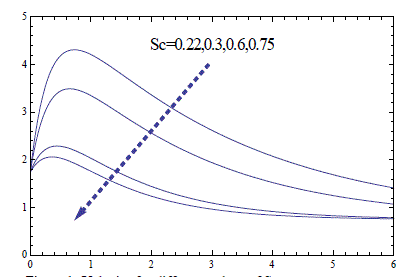ISSN ONLINE(2319-8753)PRINT(2347-6710)
ISSN ONLINE(2319-8753)PRINT(2347-6710)
S.Anuradha1, D.Subbulakshmi2
|
| Related article at Pubmed, Scholar Google |
Visit for more related articles at International Journal of Innovative Research in Science, Engineering and Technology
An unsteady free convection slip flow with Heat and Mass transfer effect of viscous incompressible fluid through a porous medium in a rotating system with Hall Effect, thermal radiation and chemical reaction have been studied. The plate moves with constant velocity U0 in its own plane. A perturbation technique is used to obtain the expressions for velocity, temperature and concentration. Expressions for Skin friction, Nusselt number and Sherwood number are also derived
Keywords |
| Hall current, Thermal radiation, porous medium, chemical reaction |
INTRODUCTION |
| Magneto hydrodynamic (MHD) free convection flow through porous media are very important particularly in the fields of petroleum technology for the flow of oil through porous rocks, in chemical engineering for the purification and filtration processes and in the cases like drug permeation through human skin. Free convection arises in the fluid when temperature and concentration changes cause density variation leading to buoyancy forces acting on the fluid elements. The mass transfer differences affect the rate of heat transfer. Recently, it is of great interest to study the effect of magnetic field on the temperature distribution and heat transfer when the fluid is not only an electrical conductor but also when it is capable of emitting and absorbing thermal radiation. The radiative free convective flows are encountered in countless industrial and environment processes e.g. heating and cooling chambers, fossil fuel combustion energy processes, evaporation from large open water reservoirs, astrophysical flows, solar power technology and space vehicle reentry. The radiative heat transfer plays an important role in manufacturing industries for the design of reliable equipment. This chapter deals with the effects of hall current, thermal radiation, chemical reaction, soret number etc., on an unsteady, rotating, free convection slip flow past an infinite vertical porous plate, embedded in a porous medium, with constant heat and mass flux at the plate. The analytical expressions for the velocity, temperature and concentration are obtained using perturbation technique. The effects on velocity, temperature and concentration are discussed through graphs. |
II. RELATED WORK |
| Sivaiah et al. [1] and Das and Jana [2] have studied heat and mass transfer effects on MHD free convection flow past a vertical plate with different boundary conditions. Chaudhary and Jain [3] have also studied combined heat and mass transfer effects on MHD free convection flow past an oscillating plate. Aboeldahab et al. [4] and Shit [5] studied the effects of Hall currents on MHD free convection flow with mass transfer. Acharya et al. [6] studied the magnetic effects on the free convection and mass transfer flow through porous medium. The no slip boundary condition is valid only when particles close to the surface do not move with the flow; however this is only true macroscopically. Effect of Hall currents, with slip conditions at the boundary have been studied by Abbas and Asghar [7] and Jain and Gupta [8]. Jain and Singh [9], have observed Hall and thermal radiative effects on an unsteady rotating free convection slip flow. Anjalidevi and Kandasamy [11] investigated the effect of chemical reaction on the flow in the presence of heat transfer and magnetic field. Chemical reaction effects on heat and mass transf er in laminar boundary layer flow have been studied by several scholars e.g. Kandasamy et al. [12], Afify [10], Takhar et al. [14] and Mansour et al. [13] etc. |
III. MATHEMATICAL FORMULATION |
 |
 |
 |
V. RESULTS AND CONCLUSION |
| Increasing values of Sc, Pr, Kr results in decrease in velocity. Figure 6, velocity (u) profiles are plotted against z. We fix t = 1, Kr=0.2, Pr=0.71 and Sc = 0.61. It is observed that on increasing K, Gr, Gc and So, velocity increases. Temperature profiles are plotted against z in Figure 4 by fixing t = 1. From the figure we observe that as we increase the radiation our temperature drops as heat is being radiated while the effect of absorption is obvious, the temperature rises. Also, increase is H, which is source parameter, decreases the temperature. In Figure 5, effects of different parameters are studied on concentration (C), profiles are plotted against z fixing t = 1. We observe that on increasing the Schmidt number (Sc) our concentration drops, while concentration rises on increasing the Soret number (So) and H. It’s interesting to note that when we increase R concentration decreases. |
 |
 |
References |
|